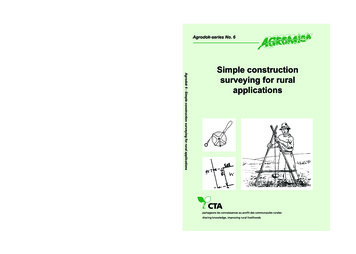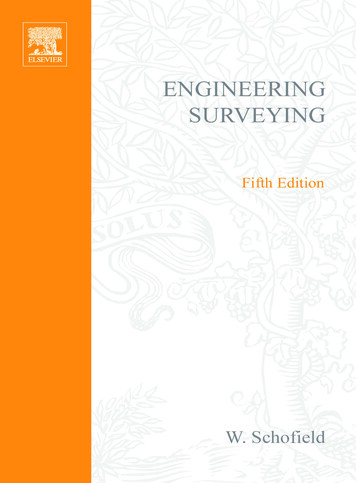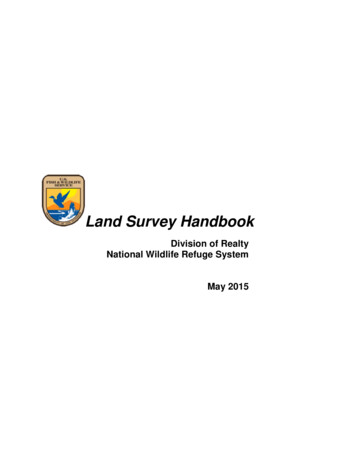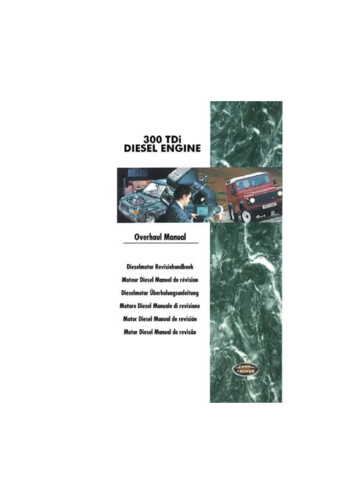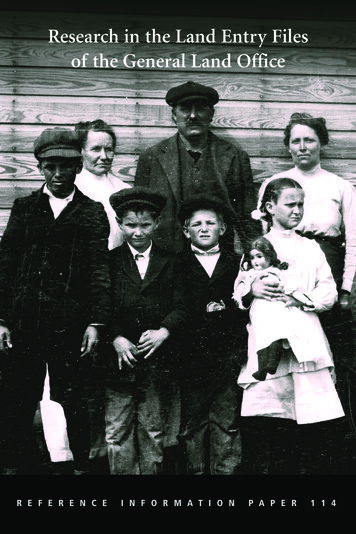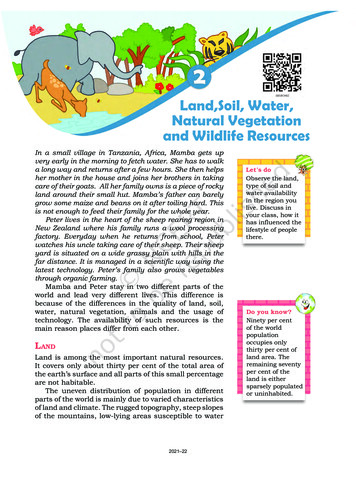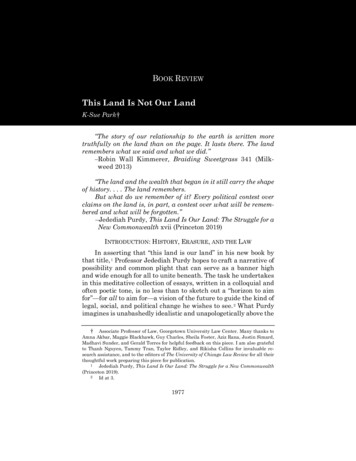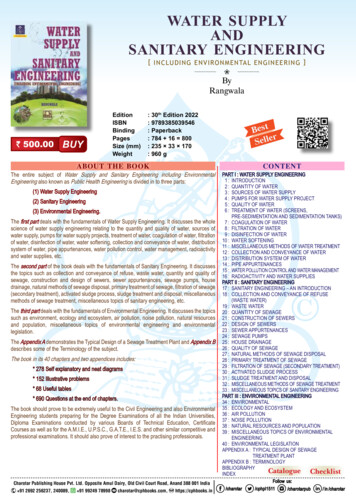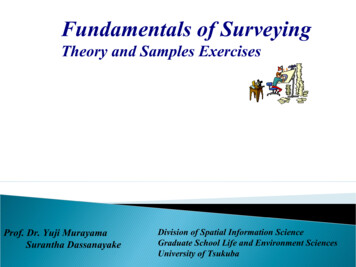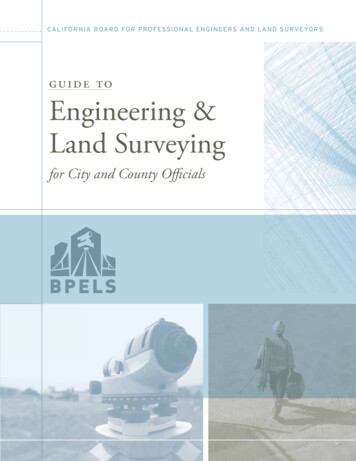
Transcription
CA LI FO RNIA BOARD FOR PROF ESSI O N A L E N GI N E E RS A N D LA N D SU RV EYO R Sguide toEngineering &Land Surveyingfor City and County Officials
guide to Engineering & Land Surveying for City and County OfficialsCalifornia Department of Consumer AffairsBoard for Professional Engineers, Land Surveyors, and Geologists2535 Capitol Oaks Drive, Suite 300Sacramento, CA 95833-2944tel: (866) 780-5370 (toll-free) or (916) 999-3600fax: (916) 263-2246internet: www.bpelsg.ca.gove-mail: BPELSG.Enforcement.Information@dca.ca.gov
table of ContentsINTRODUCTION2ENGINEERS4Practice Act, Title Act, and Title Authority4Offering Engineering Services5Engineers’ Responsibilities7Building Officials Responsibilities with Respect to the Professional Engineers Act12Signing and Sealing12PLAN CHECKING15LAND SURVEYORS16Offering Land Surveying16Land Surveyor’s Responsibilities17Signing and Sealing24CONTRACTORS26ENGINEERING, LAND SURVEYING, AND ARCHITECTURAL SERVICES27VIOLATIONS, COMPLAINTS, AND LETTERS OF INQUIRY28COMPLAINT FORM29
guide to Engineering & Land Surveying for City and County OfficialsINTRODUCTIONThis guide was written to serve as a quickreference for California’s city and countybuilding officials, county surveyors, cityengineers, and public works officials to helpanswer questions about engineers and landsurveyors—what they can do or cannot doand what constitutes unlicensed practice.Your comments are encouraged so that wecan update and revise this guide to includeinformation you need. Please telephone, writeor e-mail the Board’s Enforcement Unit if youhave a question that is not answered here.2
How can city and county officials help the Board? In order to do our job, we need thesupport and assistance of city and county officials, city engineers, and county surveyors.California consumers are much more likely to discuss issues with a city or county officialrather than Board staff. As a city or county official or county surveyor, you see the peoplewho hire engineers and land surveyors. You can let consumers know that if they have acomplaint, they can contact the Board’s Enforcement staff. Te Board investigates consumercomplaints and takes legal action when the law is violated. You are also encouraged todistribute the Board’s Consumer Guide to Professional Engineering and Professional LandSurveying publication to consumers.What resources can the Board provide to me? We hope to help you by answering yourquestions, either here, on the telephone, through e-mail, at Enforcement Outreach meetingsscheduled with your office, or via other printed information. A copy of the Board’s complaintform in included at the back of this guide. You may make copies yourself or request copiesfrom the Board’s office. We’ve also published a Consumer Guide to Professional Engineeringand Professional Land Surveying to help consumers decide when they need an engineer orland surveyor, how to hire one, and what to expect. Call, write, or e-mail the Board to havemultiple copies sent to your agency. Te Consumer Guide and the Complaint Form are alsoavailable online at www.bpelsg.ca.gov. If you’d like to schedule an Enforcement Outreachmeeting to discuss the Board’s laws and rules or problems you frequently encounter, contactthe Board’s Enforcement Unit at (866) 780-5370 (toll free) or via e-mail atBPELSG.Enforcement.Information@dca.ca.gov.Where can I get a copy of the laws dealing with engineers and land surveyors? T epowers and duties of the Board rest with the authority given in the Professional EngineersAct (Business and Professions Code §§ 6700 - 6799), the Professional Land Surveyors Act(Business and Professions Code §§ 8700 - 8805), and the Board’s regulations as codifi edin Title 16, California Code of Regulations, §§ 400 – 476 (often referred to as the “BoardRules”). Te laws are available on the Board’s Web site at www.bpelsg.ca.gov.Abbreviations Used in this GuidebookB&P Code – Business and Professions CodeCCR – California Code of RegulationsBoard – Board for Professional Engineers and Land Surveyors§ - section (as in B&P Code § 6700)§§ - more than one section3
guide to Engineering & Land Surveying for City and County OfficialsENGINEERSPRACTICE ACT, TITLE ACT, AND TITLE AUTHORITY1.There are three categories of licensure in California: Practice Acts,Title Acts, and Title Authorities.A. Te practice acts consist of civil, electrical, and mechanical engineering. Only aperson licensed with the Board in the appropriate discipline may practice or offer topractice these disciplines. Tere are, however, several exemptions to the ProfessionalEngineers Act, listed under Business and Professions Code §§ 6739 – 6747.Civil engineering includes studies or activities in connection with fixed works forirrigation, drainage, waterpower, water supply, flood control, inland waterways,harbors, municipal improvements, railroads, highways, tunnels, airports and airways,purification of water, sewerage, refuse disposal, foundations, grading, framed andhomogeneous structures, buildings, or bridges. Civil engineering also includes cityand regional planning concerning the features listed above. Civil engineers licensedprior to January 1, 1982, (with a license number before 33966) are authorized topractice all land surveying and engineering surveying. (B&P Code §§ 6731, 6731.1)Electrical engineering includes studies or activities relating to the generation,transmission, and utilization of electrical energy, including the design of electrical,electronic and magnetic circuits and the technical control of their operation andof the design of electrical gear. It is concerned with research, organizational andeconomic aspects of the above. (B&P Code § 6731.5)Mechanical engineering deals with engineering problems relating to generation,transmission, and utilization of energy in the thermal or mechanical form and alsowithin engineering problems relating to the production of tools, machinery, andtheir products and to heating, ventilation, refrigeration and plumbing.(B&P Code § 6731.6)B. Te title acts consist of the branches of Agricultural, Chemical, Control System, FireProtection, Industrial, Metallurgical, Nuclear, Petroleum, and Traffic Engineering.Only a person licensed in that engineering branch may use the title of that branch.4
Te title is regulated, but the practice is not. Anyone—whether or not they arelicensed—may practice in any of the title act disciplines. Each title act branch isdefined in Title 16, California Code of Regulations, § 404.C. Title authorities apply to two specialized areas of civil engineering: structuralengineering and geotechnical engineering. Only the use of the title is restricted.Civil engineers may choose to obtain the additional licenses giving them the authorityto use the titles “Structural Engineer,” “Geotechnical Engineer,” “Soil Engineer,”and “Soils Engineer.” Any civil engineer may practice structural engineering orgeotechnical engineering except in specifically restricted areas. Specifically, only astructural engineer may design a hospital or public school (primary, secondary, andjunior college). (Tese restrictions are contained in the Health & Safety Code andthe Education Code.) Civil engineers may perform all geotechnical work. Te titles“Geotechnical Engineer,” “Soil Engineer’” and “Soils Engineer” are synonymous.Since structural engineering and geotechnical engineering are part of the practice ofcivil engineering, and since all structural engineers and geotechnical engineers arealso civil engineers, any reference to “civil engineering” or “civil engineer” inherentlyincludes structural and geotechnical engineering and structural and geotechnicalengineers. (B&P Code §§ 6736, 6736.1)2.Is there a difference between “registered” and “licensed” forengineers? (B&P Code § 6732)No. Te terms are interchangeable.3.Can all licensed engineers use the titles or abbreviations of the titles,“Professional Engineer,” “Consulting Engineer,” “Licensed Engineer,”and “Registered Engineer”? (B&P Code § 6732)Yes. All engineers licensed in any branch may use these titles, in addition to theirspecific branch titles.OFFERING ENGINEERING SERVICES4.Can an unlicensed person offer engineering services?(B&P Code §§ 6730, 6732, 6736, 6736.1)An unlicensed person cannot offer to practice civil (including structural andgeotechnical), electrical, or mechanical engineering services, unless otherwise exempt.An unlicensed person can offer to and practice any of the “title act” branches ofengineering. See previous section on Practice Act, Title Act and Title Authority foradditional information.5
5.Can an unlicensed person use the title “engineer”?(B&P Code § 6732)Te word “engineer” by itself is considered generic and is not regulated. However, itis unlawful for anyone to use the title “Professional Engineer,” “Licensed Engineer,”“Registered Engineer,” or “Consulting Engineer,” or any of the following titles, orany combination of such words and phrases or abbreviations unless licensed in therespective branch or authority of engineering.Civil EngineerAgricultural EngineerMetallurgical EngineerElectrical EngineerChemical EngineerNuclear EngineerMechanical EngineerControl System EngineerPetroleum EngineerStructural EngineerFire Protection EngineerTraffic EngineerGeotechnical Engineer orSoil Engineer orSoils EngineerIndustrial EngineerIt is also unlawful for an unlicensed person to use the title “engineer” in any waythat would misrepresent that he or she is licensed by this Board or that he or she isauthorized to practice civil, electrical, or mechanical engineering.Te Board no longer regulates the titles “Corrosion Engineer,” “ManufacturingEngineer,” “Quality Engineer,” and “Safety Engineer.” Anyone may use these titles,whether or not they are licensed. However, individuals who obtained licensure in thesedisciplines before the titles were deregulated and who maintain their licenses by payingtheir renewal fees may used the titles “Registered Engineer,” “Licensed Engineer,”“Consulting Engineer,” and “Professional Engineer.”6.Can an unlicensed person own an engineering business?(B&P Code § 6738)An unlicensed person cannot be the sole owner of an engineering business offering civil(including structural and geotechnical), electrical, or mechanical services. However, anunlicensed person may be a partner or officer, provided that a licensed engineer is also apartner or officer in charge of the engineering practice of the business.7.Does an engineering business need to be licensed by the Board?(16 CCR § 463; B&P Code § 6738)No, but a licensed engineer who is associated as a partner, member, officer, or employeein responsible charge of professional engineering services offered or performed by afirm, partnership, or corporation must file an Organization Record with the Boardwithin 30 days of such association.6
ENGINEERS’ RESPONSIBILITIES8.What does the term “responsible charge” mean as applied toprofessional engineering? (B&P Code § 6703; 16 CCR § 404.1)“Responsible charge” relates to the extent or degree of control a licensed engineer isrequired to maintain while exercising independent control and direction of engineeringservices or creative work, and to the engineering decisions which can be made onlyby a licensed engineer. It does not refer to the concepts of management, hierarchy, orfinancial liability.Te extent of control necessary to be in responsible charge shall be such that thelicensed engineer:a) Makes or reviews and approves the engineering decisions (described below).b) In making or reviewing and approving the engineering decisions, determines theapplicability of design criteria and technical recommendations provided by othersbefore incorporating such criteria or recommendations.Engineering decisions include those within the purview of the ProfessionalEngineers Act. Tey do not include decisions concerning administrative or personnelmanagement. Engineering decisions of the licensed engineer in responsible charge mayinclude, but are not limited to:a) Te selection of engineering alternatives to be investigated and the comparison ofalternatives for the project;b) Te selection or development of design standards or methods, and materials to be used;c) Te decisions related to the preparation of engineering plans, specifications,calculations, reports, and other documents for the engineered works;d) Te selection or development of techniques or methods of testing to be used inevaluating materials or completed projects, either new or existing;e) Te review and evaluation of manufacturing, fabrication or construction methodsor controls to be used and the evaluation of test results, materials and workmanshipinsofar as they affect the character and integrity of the completed project;f ) Te development and control of operating and maintenance procedures.Questions to be answered by the licensed engineer in responsible charge may relate tothe criteria for design, methods of analysis, methods of manufacture and construction,selection of materials and systems, and environmental considerations. Te licensedengineer should be able to clearly express the extent of control and how it is exercised andto demonstrate that the licensed engineer is answerable within the extent of control.7
guide to Engineering & Land Surveying for City and County Officials9.What structures or parts of structures can an unlicensed persondesign? (B&P Code §§ 6731, 6737.1, 6745)An unlicensed person may prepare plans, drawings, or specifications for:a) Single family dwellings of wood frame construction not more than two stories andbasement in height;b) Multiple dwellings with not more than four dwelling units of wood frameconstruction not more than two stories and basement in height;c) Garages and other structures appurtenant to buildings described above, of woodframe construction and not more than two stories and basement in height.d) Agricultural and ranch buildings of wood frame construction, unless the buildingofficial having jurisdiction deems an undue risk to the public health, safety, orwelfare is involved;If any portion of a) through d) deviates from conventional framing requirements forwood frame construction found in Title 24 of the California Code of Regulations orother state or local building codes, such portions shall be designed by, or under theresponsible charge of, a licensed architect or licensed engineer.An unlicensed person may prepare the plans, drawings, and specifications for anyalterations or additions to any buildings necessary to the installation of store fronts,interior alterations or additions, fixtures, cabinet work, furniture, appliances orequipment as long as the alterations or additions do not affect the structural safety ofthe building.10. Can a contractor prepare electrical or mechanical drawings?(B&P Code § 6737.3)A contractor appropriately licensed by the Contractors State License Board (CSLB) mayonly design electrical or mechanical systems which he or she will install. An employeeof the contractor may perform the installation. However, the contractor cannotsubcontract the installation to another contractor.11.Must all plans, specifications and reports contain the professionalengineer’s seal and signature?(B&P Code §§ 6735, 6735.3, 6735.4; 16 CCR § 411)Only final documents – those which have been finalized, permitted, or released forconstruction – are required to be signed and stamped. Tey must also include thedate on which they are signed and stamped. Te presence of the responsible chargeengineer’s signature and stamp and date of signing is intended to represent that thosedocuments have been completed, reviewed, permitted, or are ready to be released forconstruction. Interim documents (such as drafts, preliminary documents, work-inprogress documents, or building department review documents) must include the8
name and license number of the licensed engineer in responsible charge. Tese interimdocuments must also include a notation indicating their status, such as “preliminary,”“for plan check only,” or “not for construction.”12. Can a local agency require all engineering documents that aresubmitted for review to be signed and sealed?(B&P Code §§ 6735, 6735.3, 6735.4)A local agency may adopt ordinances or regulations to require that all engineeringdocuments submitted for review be signed and sealed. However, the interim documents,even if signed and sealed, must still contain the interim notation as required by state law.13. What information must be included in a professional engineer’s seal?(16 CCR§ 411)Te professional engineer’s seal (stamp or digital representation) must contain thelicensed engineer’s name, license number, and branch or authority of engineeringin which licensed.14. Can an unlicensed person use the seal or stamp of a licensed engineer?(B&P Code §§ 6732, 6735, 6735.3, 6735.4)No. It is unlawful for anyone other than a licensed professional engineer to stamp orseal any plans, specifications, reports, or other engineering documents. An unlicensedperson cannot sign for a licensed person.15. Are licensed engineers required to have liability insurance or be bonded?No. Te laws do not require licensed engineers to have liability insurance or be bonded.16. Can an unlicensed person practice civil engineering?(B&P Code §§ 6730.2, 6732, 6736, 6736.1, 6739, 6740, 6746)Only if the person is:a) A federal officer or employee;b) An employee of the state, or any city or county, who was in responsible charge ofengineering work on or before January 1, 1985, until such time that person is replaced;c) Working under the responsible charge of a licensed civil engineer;d) An employee of a communications company under the jurisdiction of the PublicUtilities Commission (PUC), or an employee of a contractor engaged in work forsuch a communications company, while engaged in work on communication linesand equipment for communications companies under the jurisdiction of the PUC.Individuals covered by these exemptions may not use any of the restricted titles listed inB&P Code Sections 6732, 6736, or 6736.1.9
guide to Engineering & Land Surveying for City and County Officials17. When can an unlicensed person practice mechanicalor electrical engineering?(B&P Code §§ 6730.2, 6737.3, 6739, 6740, 6746, 6746.1, 6747)An unlicensed person can practice mechanical or electrical engineering if he or she is:a) A federal officer or employee;b) An employee of the state, or any city or county, who was in responsiblecharge of engineering work on or before January 1, 1985, until such timethat person is replaced;c) Working under the responsible charge of a licensed mechanical or electrical engineer,as appropriate;d) An employee of a communications company or an employee of a contractorengaged in work for such a communications company, while engaged on work oncommunication lines and equipment for a communications company;e) An employee, consultant, temporary employee, a person hired pursuant to a thirdparty contract, or a contract employee of a manufacturing, mining, public utility,research and development, or other industrial corporation provided that work is inconnection with the products, systems, or services of that corporation or its affiliates;f ) A contractor appropriately licensed by the Contractors State License Board (CSLB)and only designs electrical or mechanical systems which he or she will install. Anemployee of the contractor may perform the installation. However, the contractorcannot subcontract the installation to another contractor.18. Who can practice geotechnical engineering?(B&P Code §§ 460, 6736.1)All civil engineers are legally authorized to practice geotechnical engineering.Tis includes preparing soils reports.Geotechnical engineers are civil engineers who have obtained an additionallicense which authorizes them to use the title “Geotechnical Engineer.” Te terms“Geotechnical Engineer,” “Soil Engineer,” and “Soils Engineer” are synonymous.Local agencies cannot require a geotechnical engineer to prepare geotechnicalengineering documents rather than a civil engineer.19. Can licensed geologists and licensed engineering geologistspractice civil engineering?No. Tere is no exemption in the Professional Engineers Act that allows licensedgeologists or licensed engineering geologists to practice civil engineering.10
20. Can a civil engineer sign mechanical or electrical engineeringdrawings if the civil engineer is not licensed in those disciplines?(B&P Code § 6737.2)Yes, as long as the electrical or mechanical work is in connection with orsupplementary to civil engineering work.21. Can a mechanical engineer sign civil or electrical engineeringdocuments? (B&P Code §§ 6704, 6730, 6732, 6735, 6735.3, 6735.4)No.22. Can an electrical engineer sign civil or mechanical engineeringdocuments? (B&P Code §§ 6704, 6730, 6732, 6735, 6735.3, 6735.4)No.24. Who can practice structural engineering?(B&P Code §§ 460, 6736; Health & Safety Code § 129805;Education Code § 17302)All civil engineers are legally authorized to practice structural engineering under theProfessional Engineers Act. However, only structural engineers may design hospitalsor public schools, pursuant to the Health and Safety Code and the Education Code.Structural engineers are civil engineers who have obtained an additional license whichauthorizes them to use the title “Structural Engineer.”Local agencies cannot require a structural engineer to prepare structural engineeringdocuments rather than a civil engineer.25. Can someone with an expired (delinquent) license still practice civil,structural, geotechnical, electrical, or mechanical engineering?(B&P Code §§ 6733, 6796, 6796.3)No. If the license is expired (delinquent), the person cannot practice, offer to practice,or act as a consultant. However, as with any unlicensed individual, the person may workunder the responsible charge of a licensed engineer.26. Can someone with a cancelled, denied, retired, revoked, suspended,or surrendered license still practice civil, structural, geotechnical,electrical, or mechanical engineering? (B&P Code §§ 6733, 6796.1, 6796.2)No. If the license has a status of cancelled, denied, retired, revoked, suspended orsurrendered, the person cannot practice, offer to practice, or act as a consultant.However, as with any unlicensed individual, the person may work under the responsiblecharge of a licensed engineer.11
27. If the license has expired between the time the engineering documentswere prepared and the time when the local agency’s review isperformed, do the documents need to be re-sealed by a licensee with acurrent license? (B&P Code §§ 6733, 6735, 6735.3, 6735.4)As long as the license was current at the time the engineering documents were prepared,the documents do not need to be re-sealed prior to review by the local agency. However,any changes (updates or modifications) to the documents that are made following thereview by the local agency would have to be prepared by a licensed engineer with acurrent license and those changes would have to be signed and sealed.BUILDING OFFICIALS RESPONSIBILITIES WITH RESPECTTO THE PROFESSIONAL ENGINEERS ACT28. Are building officials required to verify whether the individual whoprepares engineering documents has a current license?Tey are not required to do so by law, however, the Board encourages buildingofficials to verify licensure. Building officials may verify that the individual whoprepares engineering documents is currently licensed or is working under theresponsible charge of a licensed engineer. To verify licensure online, visit theBoard’s Web site at www.bpelsg.ca.gov or call (866) 780-5370.29. Can a building official require a civil engineer to prepare plans,drawings, specifications, or calculations for portions of a wood-framedresidential structure? (B&P Code § 6737.1)Yes. If any portion of any structure exempted by section 6737.1 deviates fromsubstantial compliance with conventional framing requirements for wood frameconstruction found in the most recent edition of Title 24 of the California Codeof Regulations or tables of limitation for wood frame construction, as definedby theapplicable building code duly adopted by the local jurisdiction or the state, thebuilding official having jurisdiction shall require the preparation of plans, drawings,specifications, or calculations for that portion by, or under the responsible charge of, alicensed architect or licensed engineer. Te documents for that portion shall bear thestamp and signature of the licensee who is responsible for their preparation.SIGNING AND SEALING30. What engineering documents are required to be signed and sealed?(B&P Code §§ 6735, 6735.3, 6735.4; 16 CCR § 411)12
All final civil (including geotechnical and structural), electrical, or mechanicalengineering plans, specifications, reports, or documents must bear the professionalengineer’s seal or stamp, as well as his/her signature. If there are multiple pages, the sealor stamp, and signature must appear on each sheet of the plans, and on the original titlepage of the specifications, calculations and reports. Each licensee shall include the dateof signing and sealing immediately below or next to the signature and seal.Interim (non-final) documents are not required to be signed and sealed. However,the interim documents must include the name and license number of the engineer,as well as a notation as to their intended purpose, such as “for review only,” “not forconstruction,” or “draft.”31. Are professional engineers and land surveyors required to includetheir license expiration date when they sign and seal engineering orland surveying documents? (B&P Code §§ 6735, 6735.3, 6735.4, 6764,8750, 8761 & 8764.5)No. January 1,2010, professional engineers and land surveyors are no longer requiredto include their license expiration date when they sign and seal engineering or landsurveying documents. It is also no longer required that the license expiration date beincluded in their professional seal/stamp.32. Are electronic seals and/or signatures acceptable?(16 CCR § 411)Yes. Licensed engineers may choose to affix their signature and seals to their documentsthrough electronic means. However, a rubber stamp of the signature is prohibited andmay not be used. A rubber stamp for the seal is acceptable. Local agencies may adoptordinances or regulations requiring “wet” stamps and/or signatures.33. Can a civil engineer sign mechanical or electrical engineeringdrawings if the civil engineer is not licensed in those disciplines?(B&P Code § 6737.2)Yes, as long as the electrical or mechanical work is in connection with or supplementaryto civil engineering work.34. Who can sign and seal for the engineering design of buildingcomponents? (B&P Code § 6735; 16 CCR §§ 404.1, 411)A licensed engineer designing a portion of a building is in responsible charge of theengineering of that portion of the project and is required to seal and sign the documentsrelated to that portion of the project. Te licensed engineer must indicate on alldocuments exactly which portions he or she is in responsible charge of.13
35. What happens when a licensed engineer does not complete a projectand a new licensed engineer takes over? (16 CCR §§ 404.1, 411)Te new licensed engineer (successor licensee) may assume responsible charge of a projectand complete the design as long as he or she exercises the extent of control and assumedresponsibility for the engineering decisions. Tus, this successor licensee must reviewdrawings, calculations, studies, etc., to the degree that meets the responsible charge criteria.Te successor licensee cannot be required to assume responsibility for portions of the projectwhere responsible charge was by the original licensed engineer (stamped and signed bythe original licensed engineer). However, the original licensed engineer is not relieved ofany responsibility arising from engineering services of which he or she was in responsiblecharge (documents stamped and signed only by the original licensed engineer).36. Can a licensed engineer modify or add to a project for which anotherlicensed engineer is in responsible charge? (16 CCR § 404.1)Te licensed engineer (called a “successor licensee”) can modify or add to a projectwhich has been designed under the responsible charge of another licensed engineer.Te “successor licensee” must exercise the requisite extent of control and assume theresponsibility for the engineering decisions for all new work and for the effect thenew work has on the existing work. Te “successor licensee” is not required to assumeresponsible charge of the entire project.37. Can a licensed engineer be in responsible charge of only a portion orportions of a project? (16 CCR § 404.1)Te licensed engineer may provide services for a portion or portions of an engineeringproject as long as he or she exercises the requisite extent of control and assumes theresponsibility for the engineering decisions relating to those portions. Te licensedengineer is not required to assume responsible charge of the entire project.38. Can a local agency require all engineering documentsthat are submitted for review to be signed and sealed?(B&P Code §§ 6735, 6735.3, 6735.4)A local agency may adopt ordinances or regulations to require that all engineeringdocuments submitted for review be signed and sealed. However, the interim documents,even if signed and sealed, must still contain the interim notation as required by state law.39. What information must be included in a professional engineer’s seal?Te professional engineer’s seal (stamp or digital representation) must contain thelicensed engineer’s name, license number, and branch or authority of engineering inwhich licensed.14
guide to Engineering & Land Surveying for City and County OfficialsPLAN CHECKING40. Does the plan checking of documents prepared by alicensed engineer have to be done by a licensed engineer?(B&P Code §§ 6704, 6730, 6730.2; 16 CCR § 404.1)If the level of review done during plan checking is strictly simple code compliance—anon-discreti
guide to Engineering & Land Surveying for City and County Officials California Department of Consumer Affairs Board for Professional Engineers, Land Surveyors, and Geologists 2535 Capitol Oaks Drive, Suite 300 Sacramento, CA 95833-2944 tel: (866) 780-5370 (toll-free) or (916) 999-360
